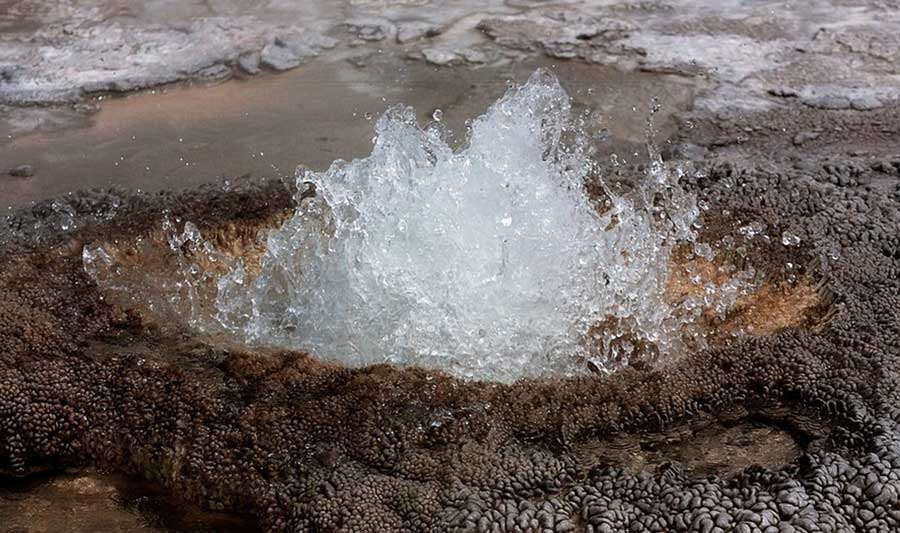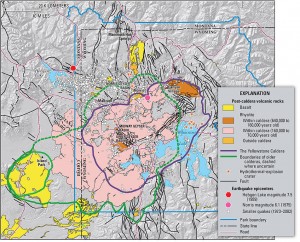
By Ruffin Prevost
CODY, WYO. — A new technique for dating rocks produced in volcanic eruptions indicates that the Yellowstone supervolcano was more active than previously thought, but also bit less super.
Researchers have just published the findings of a study that suggests a Yellowstone supervolcano eruption believed to have happened 2 million years ago was in fact two separate eruptions separated by at least 6,000 years. The discovery could require geologists studying the Yellowstone supervolcano and other similar sites to recalibrate their geologic clocks a bit, while also offering a better idea of what the future holds for the still-active region around Yellowstone National Park.
In a study funded by the National Science Foundation and published in the June issue of Quaternary Geochronology, researchers at Washington State University and the Scottish Universities Environmental Research Centre used a high-precision argon isotope dating method to make the new calculations.
“The Yellowstone volcano’s previous behavior is the best guide of what it will do in the future,” said Ben Ellis, co-author of the study and a post-doctoral researcher at Washington State University’s School of the Environment. “This research suggests explosive volcanism from Yellowstone is more frequent than previously thought.”

The Huckleberry Ridge explosion of more than 2 million years ago formed the Island Park Caldera, which lies under the western half of Yellowstone and extends into the adjacent Island Park area of Idaho. Geologists have typically accepted that the caldera and the related Huckleberry Ridge Tuff rock formations still visible in the park were formed by a single cataclysmic explosion that was among the largest in the earth’s history.
Until now, “nobody had taken the time to go out and test each part,” Ellis said Monday during a telephone interview with Yellowstone Gate.
So that’s exactly what Ellis decided to do, traveling about two years ago to the area around Flagg Ranch, just south of Yellowstone Park. The Huckleberry Ridge Tuff extends from Yellowstone south into the Grand Teton National Park area, and some of the best examples of the 2-million-year-old rocks are around Flagg Ranch, Ellis said.
The Huckleberry Ridge Tuff is visible at spots in Yellowstone’s Golden Gate Canyon, about three miles south of Mammoth Hot Springs.
The age of a supervolcano
The dating process involved crushing and cleaning rock samples before sending them to a nuclear reactor to be irradiated. When they returned, the samples were too radioactive to handle safely right away, so they had to sit in isolation for a while, Ellis said.
The radioactive decay rate of specific isotopes serves as a “rock clock” for dating samples. Developed by Ellis’ research partner, Darren Mark, study co-author and a post-doctoral research fellow at the SUERC, the technique improved on previous dating methods by 1.2 percent—a seemingly tiny difference that can become huge across the geologic time.
The results paint a new picture of a more active Yellowstone supervolcano than previously thought, and can help recalibrate the likelihood of another big eruption in the future. Before Ellis and Mark split the Huckleberry Ridge eruption into two events, it was the fourth largest known to science.
The new ages for each Huckleberry Ridge eruption reduce the volume of the first event to 2,200 cubic kilometers, roughly 12 percent less than previously thought. A second eruption of 290 cubic kilometers took place more than 6,000 years later.
The first Huckleberry Ridge Yellowstone supervolcano eruption still deserves the “super” title, Ellis said. It was one of the largest eruptions known to have occurred on Earth, and darkened the skies with ash from southern California to the Mississippi River. By comparison, the 1980 eruption of Mount St. Helens produced 1 cubic kilometer of ash, or more than 2,000 times less ash than the Huckleberry Ridge Yellowstone supervolcano eruption.
Ellis said the reactions to his study has been mixed, and it would be fair to call his results “controversial.” Some geologiests are impressed by the dating method and its findings, while others remain less than fully convinced of how the study will define early Yellowstone history and geology.
He said that he hopes geologists researching Yellowstone supervolcano history “will not just accept everything they’re told,” regardless of prevailing theories.
Ellis has already gathered rock samples tied to other Yellowstone supervolcano eruptions, and is testing them to determine whether they are all from the same event or if — like the Huckleberry Ridge samples — they are possibly the result of separate explosions that were thousands of years apart. He expects to have some results from those samples in a year or two.
Though his work could help better predict the next Yellowstone supervolcano eruption, Ellis said he would leave predictions like that to other researchers, although he understands the public fascination with the subject.
“When you go to Yellowstone, it’s very apparent the volcanism that’s active there. You can see hot material near the surface,” he said.
Ellis said he was not worried that his study might prompt a panic among armchair volcanologists who may see in it a higher likelihood of a Yellowstone supervolcano eruption in the near future.
“I don’t tend to take those things too seriously,” he said.
Contact Ruffin Prevost at 307-213-9818 or [email protected].
